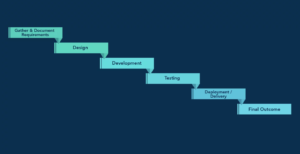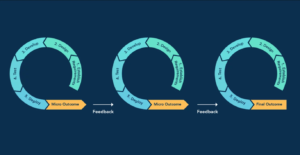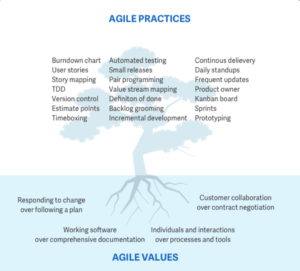
Agile Vs Waterfall in Healthcare
The healthcare sector is one of the biggest and fastest-growing industries today. It includes companies that manufacture medical equipment, drugs, provide medical services, and facilitate the provision of healthcare products (among other things).
According to the United States Bureau of Labor Statistics, healthcare occupations are expected to grow by 15 percent from 2019 to 2029. The number of nurse practitioners alone is expected to increase by a whopping 52 percent within this time frame. This growth rate is much faster than the average for all non-healthcare occupations.
The rapid growth of the healthcare industry, which is worth a staggering $4 trillion based on the data from the 2020 Forbes Healthcare Virtual Summit, brings with it the need for more efficient patient care, a reduction in costs, and a better overall experience for patients. This is known as the Triple Aim.
This is where tools for project management and extensive knowledge of project management methodologies, namely agile and waterfall, will come into play.
After reading this article, you should have a deeper understanding of the agile and waterfall methodologies as well as their pros and cons. You should also be able to determine for yourself whether adopting waterfall or agile practices is best for any given scenario.
The waterfall development methodology

This flowchart shows the step-by-step process that is used in the waterfall development methodology. Image source: (https://www.macadamian.com/learn/when-to-use-waterfall-vs-agile/) Alt-text: Flowchart depicting steps used in waterfall development methodology: Gather & Document Requirements, Design, Development, Testing, Development/Delivery, and Final Outcome.
The waterfall development methodology is an approach to creating a product or service that entails the breaking down of project functions into distinct stages. Each succeeding stage is dependent on the outcome of the previous one, and completing them sequentially, within a strict budget and timeline, is necessary.
Within the healthcare sector, most people are more familiar with the waterfall development method and are comfortable with using it in their daily activities.
Using the waterfall method allows project managers to have a clear overview of the project. It also gives them an idea of the timeline for each stage of that project.
However, one downside to using the waterfall method is that it is inflexible by nature. This means that difficulties will often be encountered if there is even a slight deviation to the project plan.
Advertisement
Waterfall development methodology pros
Below are several good points about the waterfall development methodology.
1. Extensive documentation
You won’t be able to backtrack to a previous stage of a project while using the waterfall method without wasting valuable time and resources. This forces you to create thorough documentation from the very beginning.
2. Knowledge stays in the organization
Thanks to extensive documentation, you won’t need to worry about lost knowledge in case someone from the team decides to leave the project. Also, you won’t need to spend time training new team members since they will easily be able to become familiar with the project by viewing the documentation themselves.
3. Team members can plan their time more efficiently
Team members will know in advance what they’ll be working on. This allows them to plan out their tasks more efficiently.
4. Easily understandable
Because the waterfall method lays out the project in a way that is easily understandable, project management is usually straightforward.
5. Client input isn’t required
Client input is kept to a minimum except for occasional reviews, status meetings, and necessary approvals.
Waterfall development methodology cons
Below are negative points worth looking out for when using the waterfall development methodology.
1. No backtracking
Going back and making changes to a stage in the project that has already been completed can be costly and time-consuming. This puts a lot of pressure on team members during the planning phase.
2. No room for mistakes during the requirements phase
All the other stages of the project rely heavily on the requirements phase. Making errors here can doom the project even before it makes any significant headway.
3. Deadline creep
The domino effect is common in the waterfall method. This means that once a deadline is missed in just one stage of the project, the succeeding stages will most likely be affected as well.
4. End result may not be what the client actually needs
Because client involvement is kept to a minimum, the end product may end up not being what the client actually needs. This can lead to a major overhaul in the project plan which can eat into the project’s budget.
5. Unforeseen problems
Because the waterfall method is inflexible, it can be difficult to deal with unforeseen problems when they arise.
The agile development methodology

As you can see from this flowchart, the agile method and the waterfall method are quite similar. The key difference between the two is the agile method’s added feedback loop. (Image source: https://www.macadamian.com/learn/when-to-use-waterfall-vs-agile/). Alt-text: Flowchart depicting steps used in agile development methodology: Establish Requirements, Design, Develop, Test, Deploy, Micro Outcome, Feedback and Final Outcome.
Most modern healthcare organizations prefer to use agile planning over waterfall planning. This is largely due to the healthcare sector’s growing demand for newer project management tools and methodologies that adapt to constantly changing needs while allowing team members to be both disciplined and accountable.
In a nutshell, the agile development method encourages collaboration and frequent adaptation. This is in stark contrast to the inflexible nature of the waterfall method which favors careful planning.
Additionally, because the customers themselves are much more involved in the agile process, there is a much higher probability of customer satisfaction which can be attributed to agile in customer success.

While the stages of both the waterfall and the agile method are quite similar, the practices and values couldn’t be more different. (Image source: https://activecollab.com/blog/project-management/agile-project-management). Alt-text: Image depicting numerous agile practices and values
Here are three agile practices that you can start using right now:
1. The daily standup
This is a short daily meeting which usually lasts no more than 15 minutes. It allows the team to touch base and share important information.
2. The retrospective
At various stages during the project’s development, the team makes an assessment of their performance.
The three key questions teams ask themselves are:
- What worked well for us?
- What didn’t work well?
- What can be done differently to improve results?
3. Customer demos
This is done by presenting working versions of products or services to the customer at certain points throughout the development stages.
Agile development methodology pros
Below are positive points about the agile development methodology.
1. Agile is flexible
Because agile promotes a flexible approach to project management, priorities and requirements can easily be adjusted on the fly without any real consequences
2. Agile empowers the team
A team that uses the agile development method is NOT directed by a manager. It is expected to be self-organized, allowing members to set their own working standards and timelines.
3. Agile speeds up the production process
Because less time is spent on planning and documentation, the team is able to focus more on what needs to be done in order to be able to deliver a working iteration of the product or service.
A study was even done on applying agile practices to rare disease drug development to encourage evolutionary development, adaptive planning, rapid and flexible response to change, and continuous improvement.
4. Learning is encouraged and embraced
Learning is an integral part of the production process when it comes to the agile development method. With every iteration, the team learns how to improve upon the product or service that they are currently developing.
5. More opportunity for creativity
agile works better when the product’s design and vision isn’t too well defined. This allows the team to develop the product or service in conjunction with the customer’s input.
Agile development methodology cons
Below are some of the negative points when using agile development.
1. Outcome and timeline aren’t as predictable
Though agile’s iterative approach to developing a product or service allows the team to be flexible with their scope and timeline, the drawback is that timelines are often less predictable and aren’t set in stone.
2. The customer needs to invest time in the product
In agile development, the input of the customer is vital to the production process. This means that unwanted setbacks can occur if the client is frequently unavailable.
3. Documentation isn’t available
As previously mentioned, documentation isn’t one of the priorities of the agile development method. With no documentation, lost knowledge can quickly become a major issue should any team members decide to quit.
The lack of documentation can make knowledge transfer, training, and agile implementation challenging.
Based on survey data, 23% of respondents say insufficient training, education, and best practices for implementing agile hinders the proper adoption of agile practices within the organization.
4. A lack of trust within the team can be catastrophic
Trust is crucial in the agile development method since all the team members should be working closely to produce the best results. A lack of trust within the team can cause big problems down the line.
5. Re-work is unavoidable
Because the agile method values collaboration and frequent adaptation, a lot of time is inevitably spent working, and re-working, the product or service. This usually goes on until both the development team and the client are satisfied with the end product.
Which development method should you use?
There are a number of factors that you should consider before deciding on the best methodology to use for your healthcare organization.
For instance, if your project, such as adopting new software to improve your organization’s healthcare system, has strict regulatory requirements and there is little to no room to make changes, you may want to opt for the waterfall development method.
On the other hand, if your organization doesn’t have a strict process to follow and you have the luxury of being able to work flexibly, then going with the agile method may be a better choice.
At the end of the day, knowing the strengths and weaknesses of your team, as well as having an extensive understanding of the pros and cons of both the waterfall and the agile development methods for your healthcare facility and operations, will help you make a smarter, more educated decision as to which development methodology should work best for you.